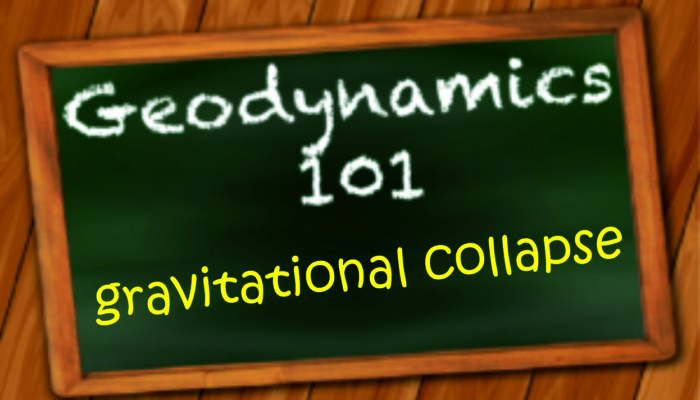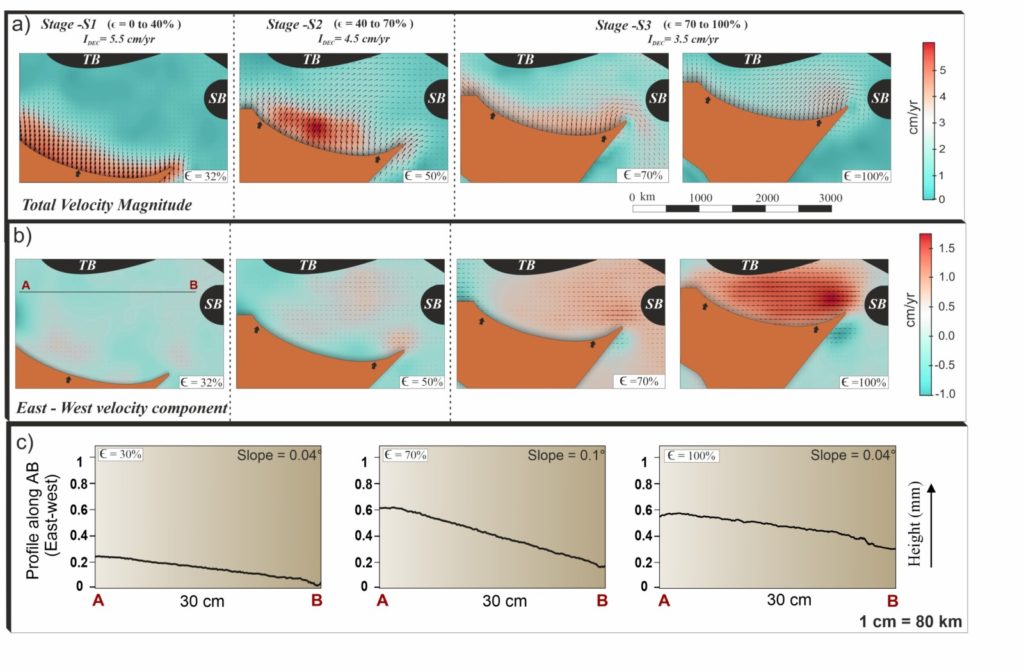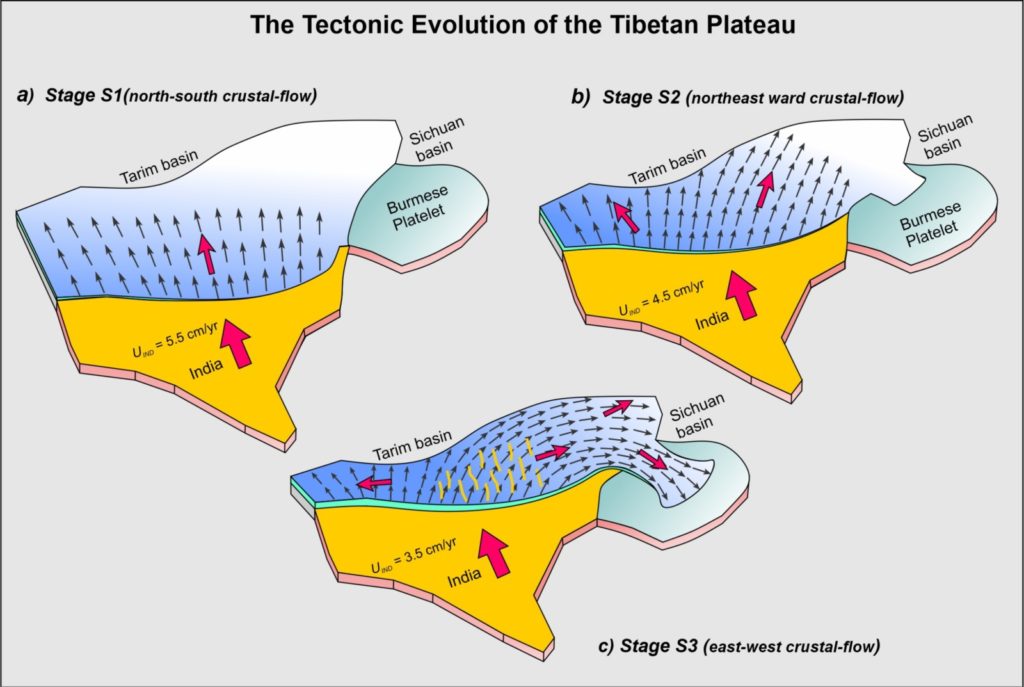
The Tibetan Plateau is the most extensive elevated surface on the Earth, stretching ~1,000 km north to south and 3,200 km east to west, with a mean elevation of greater than 4.5 km and located north of the Indian subcontinent. The formation of this Plateau has profoundly influenced the variations and evolution of Asian climate, strengthening of the South-Asian Monsoon, development of the large Asian rivers, changes in local biodiversity, and rock erosion and weathering patterns. Although the spatio-temporal evolution of the Tibetan Plateau has been a subject of study for the last 50 years, the influence of the India–Eurasia collision on the mechanisms that led to the upliftment of the high Plateau and its eventual evolution still remain a subject of debate. In this week’s blog, Arnab Roy, a PhD student at Jadavpur University, Kolkata, discusses the effects of decelerating India-Eurasia convergence on the crustal flow and topographic evolution of the Tibetan Plateau.

Figure. 1 a) Tectonic map of the Tibetan plateau showing spatial distribution of normal and strike-slip faults. b) India-Asia convergence velocity curve through time. The total India-Asia convergence length and duration have been divided in three Stages (1 to 3) where in each stage we have assumed an average indentation velocity.
The Decelerating India-Eurasia Convergence
Paleomagnetic data and plate reconstruction studies suggest that the India-Asia collision slowed the convergence rates, from 15 cm/yr at 50 Ma to 3.5 cm/yr at the present-day (Figure 1) (Copley et al., 2010) accompanied with a rearrangement of plate boundaries in the Indian Ocean. This significant reduction in the convergence motion had the potential to diminish the tectonic forcing upon the overriding Eurasian plate, resulting in the gravitational collapse of the elevated plateau in the course of collision (Copley & Mckenzie, 2007). With the help of classical scaled indentation tectonic model, Maiti et al., (2021) made an attempt to simulate and analyse the deformation in and around the Tibetan Plateau for the last ∼50 Ma as a function of the dynamic collisional kinematics governed by the decelerating India-Eurasia collision.

Figure. 2 a) Change in crustal flow pattern measured from the analogue model as India-Asia convergence velocity reduces through time. b) East-west velocity component of the total velocity field. Note that East-West velocity component increases significantly when indentation velocity reduces to present day average of 3.5 cm/yr at stage S3. c) Evolution of east-west topographic gradient in the model Tibetan plateau.
Effect of reduced convergence on the Tibetan Plateau Evolution
The experimental results demonstrate that the high-velocity crustal-flows initially localized close to the leading edge of the Indian indenter, and caused a rapid topographic uplift in southern and central Tibet during the initial stage of fast India-Asia collision (~50 Ma to ~35 Ma). In course of time, the rigid Tarim basin lying north of the Tibetan Plateau acted as a mechanical barrier to the northward crustal flows in the central Tibetan plateau, and redirected the flows in the northeast direction. Furthermore, this resistance enforced the Tibetan crust to elevate at higher rates in its western region, relative to its eastern counterpart. This resulted in a differential uplift within the Plateau which eventually led to the development of a first-order E-W topography with an eastward slope. As the Indo-Eurasian convergence slowed down significantly (at ~18 Ma), the Tibetan Plateau suffered a gravitational collapse producing strong E-W crustal flows in central and southern Tibetan region. The experimental estimates suggest extensional strain of 0.8 to 2.2 × 10−8 yr−1 in this region, which fairly agrees with the geodetic estimates (Ge et al., 2015). This extensional regime led to the formation of widespread nearly N-S trending grabens in southern and central Tibet. The experimental results also suggest that the eastward crustal flow eventually encountered the rigid Sichuan basin in eastern Tibet forcing the flow to take a clockwise turn in the southern direction, as evident from the present-day GPS data.

Figure 3. A schematic representation of the tectonic evolution of the Tibetan plateau as India-Asia convergence velocity reduces with time.
References:
Copley, A., Avouac, J. P., & Royer, J. Y. (2010). India-Asia collision and the Cenozoic slowdown of the Indian plate: Implications for the forces driving plate motions. Journal of Geophysical Research: Solid Earth. https://doi.org/10.1029/2009JB006634
Copley, A., & Mckenzie, D. (2007). Models of crustal flow in the India-Asia collision zone. Geophysical Journal International. https://doi.org/10.1111/j.1365-246X.2007.03343.x
Ge, W. P., Molnar, P., Shen, Z. K., & Li, Q. (2015). Present-day crustal thinning in the southern and northern Tibetan Plateau revealed by GPS measurements. Geophysical Research Letters. https://doi.org/10.1002/2015GL064347
Maiti, G., Roy, A., Sen, J., & Mandal, N. (2021). Impact of Decelerating India-Asia Convergence on the Crustal Flow Kinematics in Tibet: An Insight From Scaled Laboratory Modeling. Geochemistry, Geophysics, Geosystems, 22(11), e2021GC009967. https://doi.org/10.1029/2021GC009967




